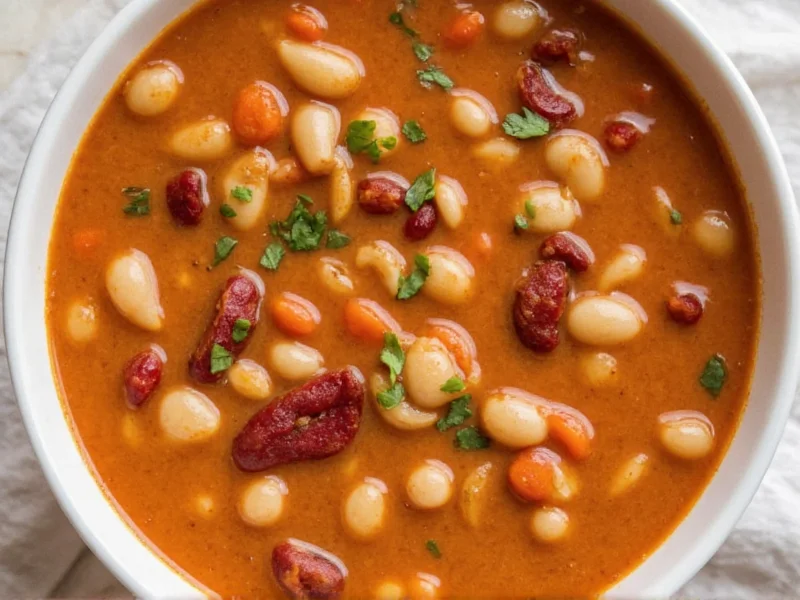Portuguese bean soup represents more than just sustenance—it's a cultural institution reflecting Portugal's agricultural heritage and resourceful cooking traditions. This humble yet flavorful dish varies across regions but maintains core elements that have nourished Portuguese families through generations. The soup's simplicity belies its complex flavor profile, developed through slow simmering that allows the smoked meats to infuse the broth with depth while the beans create a naturally creamy texture.
The Cultural Significance of Portuguese Bean Soup
In Portugal, bean soups appear in nearly every regional cuisine, each with distinctive variations. Northern Portugal favors caldo verde (though technically a kale soup), while central regions specialize in sopa de feijão with white beans. Alentejo in the south creates heartier versions with darker beans and more robust seasonings. These variations reflect local agricultural practices and historical influences.
Traditionally prepared in copper pots over wood fires, Portuguese bean soup was Sunday dinner fare, often made in large batches to last through the week. The soup's evolution demonstrates Portuguese culinary ingenuity—transforming basic pantry staples into deeply satisfying meals. Many families have guarded recipes passed down through generations, with subtle differences in spice blends or meat selections creating distinct regional identities.
Essential Ingredients for Authentic Portuguese Bean Soup
The magic of traditional Portuguese bean soup lies in its ingredient synergy. While regional variations exist, these components form the foundation of most authentic recipes:
| Core Ingredient | Traditional Portuguese Selection | Function in the Soup |
|---|---|---|
| Beans | Navy beans (feijão manteiga) or cannellini | Provides creamy texture and protein base |
| Smoked Meats | Chouriço, presunto, or ham hock | Imparts signature smoky depth |
| Aromatics | Onion, garlic, carrots, celery | Builds flavor foundation |
| Herbs | Fresh parsley, bay leaves | Adds aromatic complexity |
| Thickener | Soaked bread or pureed beans | Creates traditional creamy consistency |
Unlike some bean soups that rely on heavy cream, authentic Portuguese versions achieve their luxurious texture through bean starch and careful simmering. The smoked meats—particularly Portuguese chouriço with its distinctive paprika seasoning—provide the characteristic flavor profile that distinguishes this soup from other European bean preparations.
Traditional Portuguese Bean Soup Recipe
Creating an authentic sopa de feijão requires patience and attention to detail. This traditional preparation method yields the most flavorful results:
Ingredients
- 1 pound dried navy beans, soaked overnight
- 1 Portuguese chouriço sausage, sliced
- 1 smoked ham hock
- 2 onions, finely chopped
- 4 garlic cloves, minced
- 3 carrots, diced
- 2 celery stalks, chopped
- 3 bay leaves
- 1 bunch fresh parsley, chopped
- Salt and black pepper to taste
- 2 tablespoons olive oil
Preparation Method
- Drain soaked beans and place in a large pot with fresh water. Bring to a boil, then reduce heat and simmer for 30 minutes.
- Meanwhile, sauté onions and garlic in olive oil until translucent. Add carrots and celery, cooking until slightly softened.
- Add sautéed vegetables, chouriço, ham hock, and bay leaves to the beans. Simmer gently for 2-3 hours until beans are tender and flavors meld.
- Remove ham hock and chouriço slices. Shred meat from ham hock, discarding bone and fat, then return meat to pot.
- Using an immersion blender, partially puree the soup to create a creamy base while maintaining some whole beans for texture.
- Stir in chopped parsley and season with salt and pepper. Simmer 15 minutes more before serving.
Regional Variations Across Portugal
Portuguese bean soup transforms dramatically across the country's diverse regions:
- Northern Portugal: Features sopa de feijão branco with white beans, often including morcela (blood sausage) for added richness
- Central Portugal: Incorporates more vegetables like potatoes and cabbage, creating a heartier sopa da pedra (stone soup) variation
- Alentejo Region: Uses darker beans like feijão-coco with generous amounts of smoked meats and paprika
- Azores Islands: Includes local linguiça and sometimes adds sweet potatoes for subtle sweetness
These regional adaptations showcase Portugal's culinary diversity while maintaining the soup's essential character. The northern versions tend to be more robust with stronger smoked meat flavors, while southern preparations often feature spicier profiles reflecting Moorish influences.
Serving Traditions and Modern Adaptations
In Portugal, bean soup traditionally serves as a main course rather than a starter. It's commonly accompanied by crusty bread for dipping and a simple green salad. Many families enjoy it with a drizzle of high-quality olive oil added just before serving—a practice that enhances both flavor and nutritional value.
Modern home cooks have adapted traditional Portuguese bean soup for contemporary kitchens:
- Slow cooker method: Perfect for developing deep flavors with minimal attention—simmer on low for 8 hours
- Vegan adaptation: Substitute smoked paprika and liquid smoke for meat elements while maintaining authentic flavor profile
- Weeknight shortcut: Use canned beans (reduced sodium) with extra vegetable broth for faster preparation
- Freezer-friendly: Portuguese bean soup freezes exceptionally well for up to 3 months
Regardless of preparation method, the soup's essence remains unchanged—a celebration of simple ingredients transformed through time and care into something profoundly satisfying. The best traditional Portuguese bean soup requires no fancy techniques, just patience and respect for the ingredients.
Common Mistakes to Avoid
Even experienced cooks can stumble when preparing authentic Portuguese bean soup. Watch for these common pitfalls:
- Adding salt too early: Salting beans at the beginning can toughen skins—wait until beans are nearly tender
- Over-blending: Pureeing too much destroys the desirable texture contrast between creamy base and whole beans
- Rushing the simmer: Authentic flavor development requires slow cooking—don't shortcut the 2-3 hour simmer
- Using inappropriate beans: Stick with traditional Portuguese varieties like feijão manteiga for authentic texture
- Skipping the resting period: Allowing soup to rest overnight dramatically improves flavor integration
Mastering traditional Portuguese bean soup requires understanding these nuances. The soup's magic emerges not from complexity but from respecting time-honored techniques that allow simple ingredients to shine.











 浙公网安备
33010002000092号
浙公网安备
33010002000092号 浙B2-20120091-4
浙B2-20120091-4